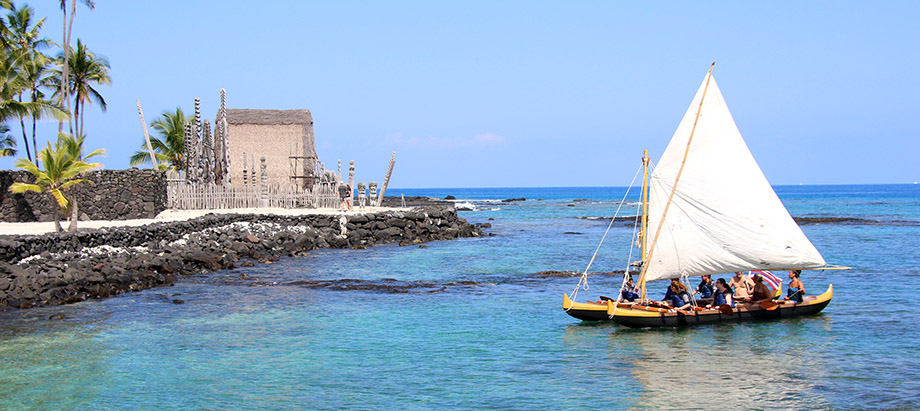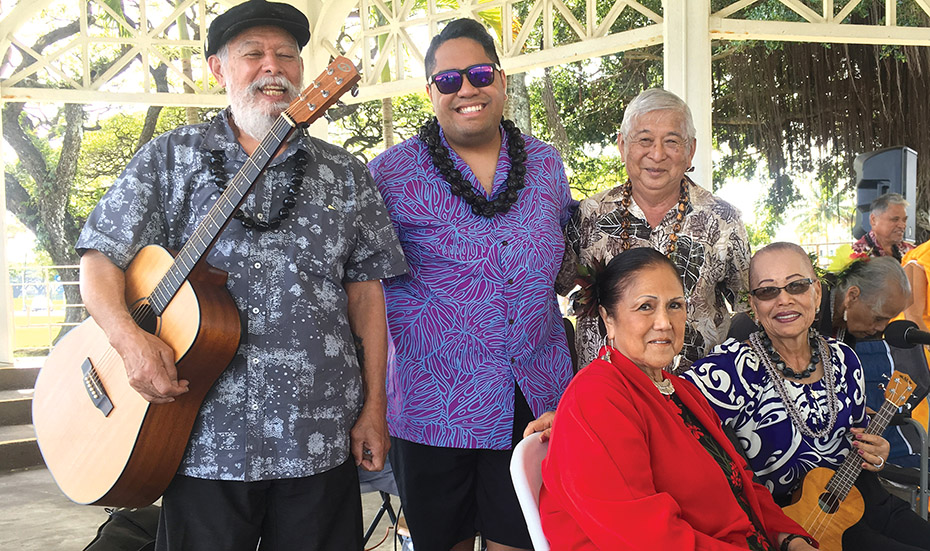
Hilo Kūpuna Share Hula with Aloha

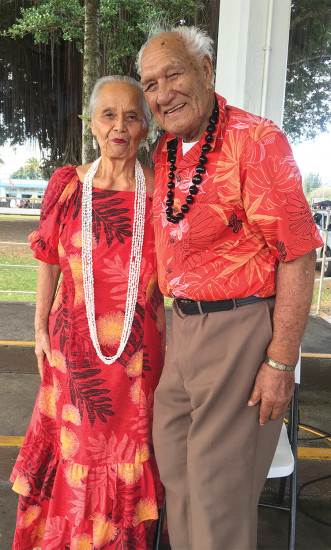
By Karen Valentine
Long before the program is set to begin, Clem and Leilani Malani, both in their 90s, are sitting in their car, waiting in anticipation. They are dressed in their finest Hawaiian aloha wear with color-coordinated red and gold holomū (dress) and aloha shirt, plus kukui nut and Ni‘ihau shell lei.
The occasion? It’s Hilo Hula Tuesday at the historic Mo‘oheau Bandstand in downtown Hilo. Clem and Leilani are two of the long-time, active volunteer musicians in the show sponsored by Destination Hilo, where the kūpuna (elders) from Alu Like’s Ke Ola Pono No Nā Kūpuna elderly services program gather to perform twice a month, dancing and playing for the visitors.
Before the show, Aunty Penny arrives with her music and colorful mu‘umu‘u. She is happy to explain how much they love doing the show every few weeks—sharing aloha, dancing hula and playing and singing their favorite kanikapila (jam-session) songs. Also dressed in formal aloha attire with fresh flowers in their hair, musicians Aunty Lei and Aunty Cissy take their places. The rainbow of colors builds on the stage.
A van pulls up and Dinnie Kysar, president of Destination Hilo, steps out and carries an armload of anthuriums and palm leaves gathered from her yard to decorate the bandstand. More colors are unveiled, red, green, and white.
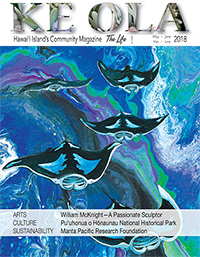
Dinnie explains that Destination Hilo, which is supported by the Hawai‘i Tourism Authority and the County of Hawai‘i Department of Research and Development, is a nonprofit organization whose mission is to enhance visitor satisfaction in East Hawai‘i and create visitor experiences, especially those involving Hawaiian culture. She is especially proud of their weekly “Hawaiian Greetings Program,” which provides music, entertainment, and information to thousands of visitors (annually) arriving at Hilo Pier and in downtown Hilo.
Setting up at a table nearby is a trio of volunteers from the Ke Ola Pono No Nā Kūpuna program. They arrange ti leaves on the table in anticipation of teaching the visitors how to make ti leaf lei. Ke Ola Pono No Nā Kūpuna, which means “Good Health and Living for the Elderly,” is funded through special grants for Native Hawaiians under the Older Americans Act. The program provides nutritional and supportive services for Native Hawaiians age 60 and older.
“We want to show the visitors a uniquely Hawaiian experience,” says Dinnie. “I’ve just come downtown from the Hilo Pier, where the Pride of America cruise ship docks every week on their Hawaiian Island cruises. We perform there, too.”
Cruise passengers from Canada and China are beginning to arrive at the bandstand, perhaps not realizing they are about to witness one of the most authentic Hawaiian cultural experiences of their entire trip. This experience is like visiting a real Hawaiian family event, with kūpuna playing ‘ukulele, keiki (children) running around, laughter and smiles all around. The aloha surrounds them, and the show is about to begin.
Emcee Ku‘ehu Mauga takes the microphone and welcomes the audience. The kūpuna hula dancers perform old Hawaiian favorites, like “E Huli Makou,” “Laupahoehoe Boy” and “Ulupalakua,” that they have been dancing since hanabata (kid-time) days. The dancers share big smiles, while winking and coaxing smiles from the crowd.
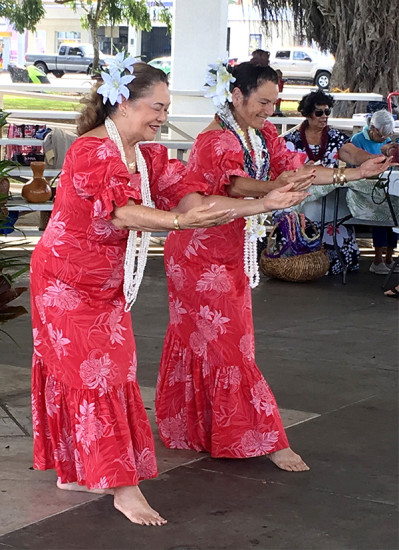
One of the dancers is Colleen “Haunani” Medeiros; program specialist since the early 1990s for the Alu Like nonprofit’s elderly services department, Kumu Kahi. Alu Like has offices in Hilo, Pāhoa and Kailua-Kona and is a statewide initiative. In addition to the Ke Ola Pono No Nā Kūpuna program with its enrichment activities, the division provides caregiver support for those family members and others who help the kūpuna.
Prior to joining Alu Like, Haunani worked for Hawai‘i Island Adult Care for 14 years, and before that she took care of her great-grandmother who passed at age 111. “It is an honor to do what I do now. This group are all able-bodied, all Hawaiian,” says Haunani.
Haunani, who is part Hawaiian, learned hula as a keiki on O‘ahu. “In hula I learned how to be humble, kind and sincere, as well as learning directly from my great-grandma. Hula is the heart of the kūpuna group.”
Alu Like is a Native-Hawaiian-only organization. Their intent is to preserve the culture, such as hula, from its roots. For these kūpuna, hula isn’t something they are just learning in a class, it is something they are sharing as outreach from ancestral wisdom.
Haunani’s boss, Rayce Bento, who is manager of Alu Like’s many Hawai‘i Island programs for all ages, says, “Our kūpuna also perform at Life Care Center of Hilo, Hale Anuenue Restorative Care Center, Hawai‘i Island Adult Care, and Prince Kuhio Plaza. For those who are shut in at the care centers, we visit them, do the hula, go around, give leis, and talk story with them.”
Alu Like earns a donation through their programs from Destination Hilo; however, Haunani says, “It’s not the money, but people seeing what the kūpuna do.”
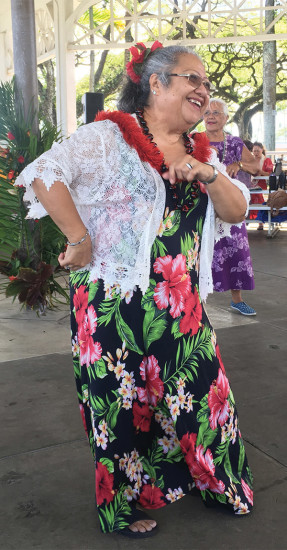
During the early days of the kūpuna hula programs, there were some 42 participants. “Kumu Hula Paul Neves at the time was a member of Malia Puka ‘O Kalani Church in Keaukaha where our Alu Like program met, Monday through Friday,” said Rayce. “The site coordinator was Veronica ‘Ronnie’ Publico and she was responsible for bringing Kumu Hula Paul’s talent to our program. He volunteered to come in and teach our kūpuna. It blossomed from there to the point where they entered the Hawai‘i Kupuna Hula Festival and came home with the first place award for the wahine group. The next year we got a men’s group together. It was so awesome. Our group has been going ever since. We owe a lot to Kumu Hula Paul for sharing his awesome talent with our kūpuna.”
On Hilo Tuesdays, “They all dress up with their beautiful mu‘umu‘u and lei,” says Haunani. She related that new members are coming in to join the program. “Our program is more than just the hula and music. We provide service coordination, information, inter-generational activities with children, health and nutrition classes and other cultural activities such as making fishing nets and headdresses; they teach one another. Through the years, we’ve grown to love each other. I have the best job in the world. The kūpuna themselves help me a lot. The best thing for me is going to work knowing I have a wonderful job that takes care of me and that I can give all my love and my talent to the people of Hawai‘i.”
Come down to the Mo‘oheau Bandstand in Hilo on Tuesdays from 11am to 12 noon to see the hula and music performances. ❖
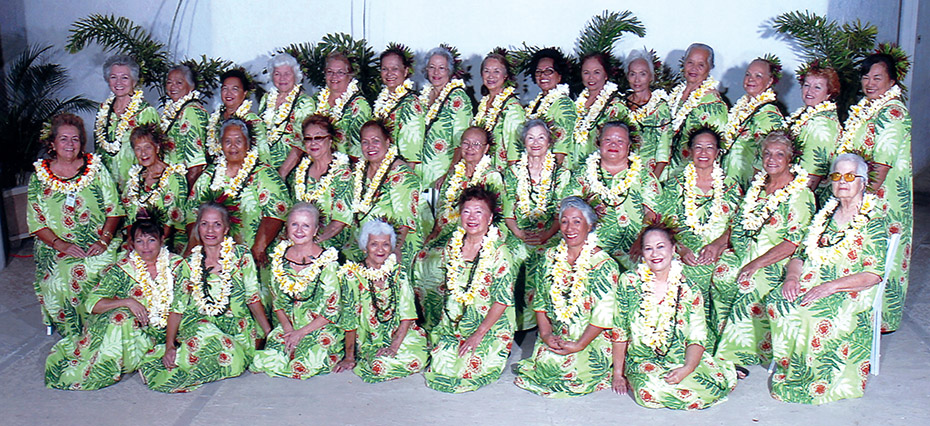
For more information: alulike.org


